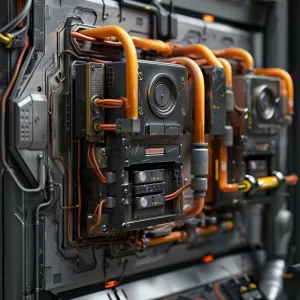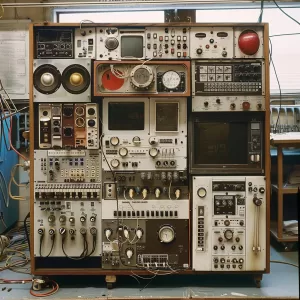
Battery Isolator vs Selector: Picking the Perfect Power Solution
February 22 2024  1035
1035
Inquiry
Global electronic component supplier AMPHEO PTY LTD: Rich inventory for one-stop shopping. Inquire easily, and receive fast, customized solutions and quotes.
QUICK RFQ
ADD TO RFQ LIST
In this blog, we will delve into the world of battery isolators and selectors, empowering you to make an informed decision for your specific setup.
What is a Battery Isolator?

What Does a Battery Isolator Do?
- Prevents Backflow: If your auxiliary battery runs out of power, the isolator keeps your starting battery fully charged and ready to start your engine.
- Automatic Operation: No manual intervention is required. The isolator works seamlessly as long as your engine is running and the charging system is active.
- Multiple Battery Banks: For systems with two or more batteries, multiple battery banks are ideal because they keep the batteries from draining into one another.
Video related to Battery Isolator
What are Selectors?

Why Selector Switch is Used?
- Manual control: This gives you the freedom to select the power source that best suits your requirements.
- Easy installation: Requiring only a rudimentary understanding of wiring, these are usually simpler to install than isolators.
- Cost-effective: In general, less costly than isolators for batteries.
Can Selectors be Grouped?
Yes. To control a complicated configuration with numerous batteries or power sources, you can combine multiple selector switches. As an example, you may have three selectors: one for starting batteries, one for supplemental batteries, and a third to combine the batteries if necessary.How Does a Battery Isolator Work?
The alternator produces charging electricity while your engine is running. By passing through the isolator, this current turns on the diodes and directs it toward the two batteries. The diodes stop any more flow from one battery to the next after the batteries are fully charged. The isolator deactivates when the engine is turned off, protecting your starting battery and isolating the batteries.How to Install a Battery Isolator?
Installing an isolator requires some electrical knowledge and tools. Consult professional help if unsure. Here's a general outline:- Identify compatible isolator: Choose one rated for your system's voltage and current.
- Disconnect batteries: Unplug both batteries from the system to ensure safety.
- Mount isolator: Select a safe spot away from heat sources and moisture to install the isolator.
- Connect cables: To connect batteries, alternators, and other parts, carefully follow the manufacturer's instructions.
- Test and verify: Measure voltages and watch charging activity to make sure everything is working properly.
How Selector Switch Works?
The selector switch has multiple positions, each connecting different batteries or combinations to the system. You manually choose the desired position based on your needs:- Starting Battery: In this configuration, the system is simply connected to the starting battery, which is perfect for engine ignition and other critical functions.
- Auxiliary Battery: When in this mode, your system is powered by the auxiliary battery, which is ideal for off-grid or accessory use without depleting your starting battery.
- Both/Combine: In this configuration, the two batteries are connected in parallel, which increases available power in high-demand scenarios but may also cause the batteries to drain more quickly.
- Off: This setting isolates every battery, stopping all current flow and guarding against battery discharge.
Battery Isolator vs Selector
| Feature | Battery Isolator | Battery Selector |
| Operation | Automatic | Manual |
| Backflow Protection | Yes | No |
| Ideal for | Frequent switching, complex setups, peace of mind | Occasional switching, simple setups, affordability |
| Installation | More complex | Easier |
| Cost | Slightly higher | Lower |
Where to Install Battery Isolator?
- Close to batteries: Reduces cable length and voltage decrease near batteries.
- Accessible location: Makes maintenance and inspection simpler.
- Protected from heat and moisture: guarantees longevity and optimum performance.
Do Battery Isolators Go Bad?
While generally reliable, isolators can malfunction due to:- Diode failure: Backflow or improper charging may result from a diode failure.
- Internal corrosion: The apparatus may sustain harm from excessive heat or dampness.
- Improper installation: Incorrect wiring can lead to malfunctions.
Conclusion
When controlling dual-battery systems, battery isolators and selectors are essential tools. Selectors give manual control and are more affordable for straightforward applications, whereas isolators offer automatic protection and are best suited for off-grid or frequent-use scenarios. You may optimize your electrical system and take pleasure in worry-free experiences by being aware of their distinctions and selecting the best selection for your particular wants.Populer Posts
OR2C04A4M84-D
Lattice Semiconductor Corporation
OR3T807BA352-DB
Lattice Semiconductor Corporation
XCS40-3BG256C
AMD
EP4SGX110DF29C2XN
Intel
5SGSMD5K1F40I2G
Intel
EP3SL150F1152C3G
Intel
5SGXEB5R3F43I3G
Intel
A54SX32A-CQ84
Microchip Technology
EP3SE260F1152C2G
Intel
1ST110EN2F43I2VGAS
Intel
5SGSMD4H2F35C2LG
Intel
